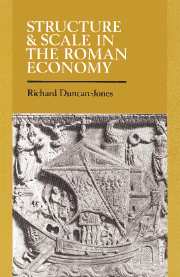Book contents
- Frontmatter
- Contents
- List of figures
- List of tables
- Preface
- List of abbreviations
- Introduction
- PART I TIME AND DISTANCE
- 1 Communication-speed and contact by sea in the Roman empire
- 2 Trade, taxes and money
- 3 Separation and cohesion in Mediterranean trade
- 4 Stability and change
- PART II DEMOGRAPHY AND MANPOWER
- PART III AGRARIAN PATTERNS
- PART IV THE WORLD OF CITIES
- PART V TAX-PAYMENT AND TAX-ASSESSMENT
- Appendices
- Bibliography
- Index
3 - Separation and cohesion in Mediterranean trade
Published online by Cambridge University Press: 13 October 2009
- Frontmatter
- Contents
- List of figures
- List of tables
- Preface
- List of abbreviations
- Introduction
- PART I TIME AND DISTANCE
- 1 Communication-speed and contact by sea in the Roman empire
- 2 Trade, taxes and money
- 3 Separation and cohesion in Mediterranean trade
- 4 Stability and change
- PART II DEMOGRAPHY AND MANPOWER
- PART III AGRARIAN PATTERNS
- PART IV THE WORLD OF CITIES
- PART V TAX-PAYMENT AND TAX-ASSESSMENT
- Appendices
- Bibliography
- Index
Summary
Evidence from Roman lamps
Signed Roman lamps (‘Firmalampen’) show some of the ways in which archaeology can increase our knowledge of trade. Their usefulness here is as a commercial artefact whose large numbers show identifiable distribution patterns. The patterns tend to suggest trading regions within the Mediterranean, divided by discernible boundaries. The boundaries imply restricted sailing patterns, and commercial zones which were more or less distinct from each other.
Pottery lamps, because they supplied household lighting by burning oil, were a standard artefact in the Roman world. Lamps produced in the western Mediterranean during the Principate survive in thousands. While many carry inventive pictorial designs, a large number are plain lamps whose main identification is a maker's name. The number of known signatures is roughly 2,000, a few being so common that they resemble modern trade marks. Frequency-counts for a number of marques were published by Harris in an important study in 1980; present indebtedness to his survey will be obvious. This discussion utilises Harris's figures, analysing some of them in greater detail.
There are serious uncertainties about how lamps of a particular marque achieved wide diffusion. At least four possibilities have been envisaged:
Long-distance export from a central production point.
Production in secondary areas under licence.
Unlicensed production in secondary areas (pirating).
Production in more than one area by lamp-makers who moved from one place to another.
The lack of sure information about where given specimens came from leaves these difficulties partly unresolved.
- Type
- Chapter
- Information
- Structure and Scale in the Roman Economy , pp. 48 - 58Publisher: Cambridge University PressPrint publication year: 1990



